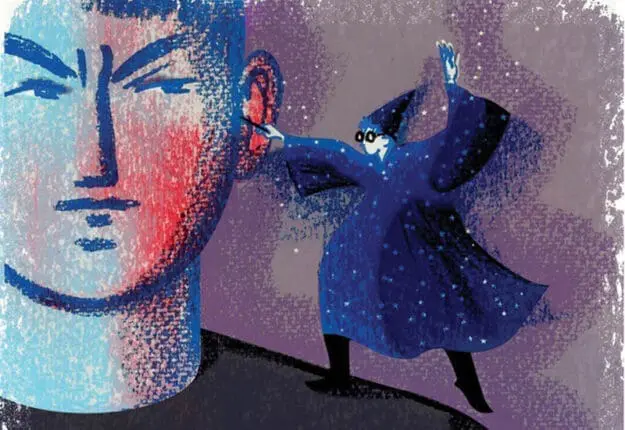“I haven’t been honest with you or my doctor. I’ve been hearing voices.” This is probably one of the last things a therapist wants to hear from a 17-year-old young man, and I must admit that my mind jumped right to thoughts of schizophrenia and other severe mental illnesses. I was filled with a sinking feeling—that Brian’s life was about to take a significant turn, and not in a direction either of us was expecting.
Brian, who’d originally presented with depression, was referred to me by his primary care doctor. He’d been seen for depression when he was about 7, but things didn’t click between the therapist and his family, so they dropped out after a few sessions. His family history was positive for depression, attention deficit hyperactivity disorder, and alcoholism. Brian revealed he’d been hearing voices in our second round of therapy. A little more than a year before, we’d started a six-month, 10-session treatment round that had ended well, but six months after we’d stopped treatment, I got a phone call from his mother. Brian had been admitted to an inpatient psychiatric unit for three days because of aggressive behavior, depressed mood, and suicidal ideation. He was being discharged that day, and the family was hoping that I could see him again.
When Brian returned to therapy, he initially made good progress, but periodically he’d have a sudden regression, becoming aggressive and depressed seemingly out of nowhere—a pattern that repeated several times. A tall, athletic teenager with a deep voice and generally constricted affect, Brain now started talking a little bit more about the voices he was hearing. He hadn’t shared that he was hearing them because he’d been concerned that I’d think he was “crazy.” I assured him that while this was a little concerning, I didn’t think he was crazy, and I was really glad that he’d let me know more about his experience.
As we continued to talk, it became clear that Brian heard the voices only when he was feeling either really down or judged by others. The voice—as it turns out, it was only one—was quite critical; it made him feel awful, even as he just imagined it while sitting in my office. It never suggested that he harm himself or anyone else, nor did it tell him to do things. But as the session was ending, Brian and I made a plan for him to contact his primary care physician or me if the voice became a pressing issue. In the meantime, we scheduled a follow-up appointment for a few days later.
Shortly after Brian left, I reached his doctor by phone and shared what was going on. His first reaction was to suggest referring Brian to a psychiatric service at a hospital about an hour away. I let the doctor know that Brian seemed to be safe, that we had a safety plan that included his parents, and that my intuition was that this wasn’t a thought disorder, but more likely related to Brian’s mood. I asked if he’d be comfortable if we monitored the situation and held off on the psychiatric consult while I worked with Brian on his mood. He agreed.
What happened next was a bit of luck. One of my clinical interests for quite some time had been Neuro-Linguistic Programming (NLP), and I’d just purchased an online training on using NLP to treat post-traumatic stress disorder. In one of the sessions, psychotherapist Steve Andreas presented a thorough and detailed process, intended to assist a client in changing a critical or troublesome internal dialogue into a supportive and helpful resource. As a practitioner of NLP since 1988, I was familiar with the pieces of the process, and I’d used all its techniques many times during my years as a psychotherapist. What was new was the way that the material had been organized into a comprehensive package. At our next session, I explained the technique to Brian and asked if he’d be willing to give it a go. He was quite open to the idea, so we got right to it.
A New Voice
I was a bit nervous as we began, because this would be a different way of working together for Brian and me. We’d never used visualization or experiential techniques before, and I wasn’t sure how he’d respond. I indicated that the first step was for him to listen to the internal voice in a different way. “Close your eyes and listen to the voice as if it were music,” I suggested to Brain. “Notice the rhythm and the tone, all the qualities other than the words themselves. We’re all able to identify the voices of many, many people, often within moments, even over the phone. What are the qualities of this voice that allow you to recognize it when you hear it?”
Brian closed his eyes and turned his attention inward. His nonverbal behavior indicated that he was listening, and he was gently nodding in response to my directions. After he’d had some time to listen to the internal voice, I asked him, “Who does the voice sound like? Who does it remind you of?”
Brian said, “It sounds like Harry Potter,” and then added with a mildly embarrassed expression, “you know, when he talks to snakes?”
“You mean parseltongue? Like Voldemort?” I asked.
“Yes. Kind of whispery and hissing,” he told me.
“Can you hear words, or is it like a foreign language?” “It’s English, just snaky.”
I was a little taken aback with the voice being that of Harry Potter, especially the darker aspect of the snakelike tonality. I was expecting a parent, or even a teacher. This had a little more of the flavor of demons and religiosity that can be associated with thought disorders. I decided to continue, but with caution.
At this point in the intervention, it can be helpful to have the client add a visual image of the speaker to the voice, so I asked Brian to imagine Harry Potter and hear him speaking in the voice. Brian was able to do this without any difficulty, so I continued, “As you watch that image of Harry while listening to his voice, notice his facial expression, the gestures he makes, and see what else you can discover about him.” Then I prompted, “Allow yourself to pull back to see a larger context in space and time. What incident comes to mind? Where are you? Perhaps you can notice what happened before the incident that just came to mind, and notice what may have happened later as a result of this experience.” These suggestions help the client see the bigger picture related to a problematic voice.
I didn’t ask Brian for any details, allowing him to remain immersed in his experience and discover things on his own. I continued to direct him to notice other aspects of his internal experience. “We all have limitations,” I said. “We’re all shaped by our upbringing, culture, and the events of our lives. Even though Harry is a fictional character, you know his story. As you continue to explore, consider how Harry’s past has created limitations for him and that what Harry said and how he said it may have more to do with those limitations and shortcomings than anything to do with you. You can even ask him for clarification. Imagine Harry was here right now and you could ask him to clarify what it is he wants to tell you. What would he say?”
Brian continued to focus his attention inward, sitting quietly and taking slow, even breaths. After a few moments, he said, “He doesn’t really have anything to add.”
I let Brian know that this was fine, and then added, “This may seem silly, but could you tell Harry, ‘Thank you’ and let him know you appreciate his help.” Brian smiled and nodded softly. Suggesting to clients that they communicate appreciation to their unconscious mind is a common strategy in NLP processes. It becomes a way to increase rapport between clients and their unconscious and enhances cooperation during the process.
Another key concept in NLP is that all behaviors have a positive intention, even if there are negative consequences. What I’d been moving toward with Brian was to be in a position where he and I could align with the voice and preserve any benefits it provided while letting go of the negative elements—in this case, creating a depressed mood and feeling criticized. As Brian continued to sit quietly, I suggested, “Ask Harry what he’s trying to get for you when he talks in that way. What’s his positive intent?”
Brian replied, “He doesn’t want me to make mistakes and look dumb.”
“Is that something that you think is important?” I asked. “Do you agree that wanting to succeed and being intelligent is a good idea for you?” Since it’s important to state the intent in a positive way, I reflected it back to Brian by offering him a slightly revised version of the stated intent. Wanting to “succeed and be intelligent” offers more opportunity for growth than avoiding “mistakes and looking dumb.”
Brian was thoughtful for a moment and then said he agreed with the positive intent. Sometimes, when a client asks for the positive intent, the first response isn’t as clearly positive to the client as it was in this case. It isn’t uncommon for clients to ask several times before they get a response that’s acceptable to them. Once again, I encouraged Brian to give sincere thanks to Harry for the positive intent. He smiled again and nodded.
Since the positive intent was something that Brian wanted to keep, we set about finding a way for the voice to assist Brian without disturbing his mood. We began by having Brian turn his attention inward again to ask his inner Harry if it’d be willing to help Brian succeed and be intelligent, but to do so in a way that worked better for Brian. Brian reported that Harry indicated he’d be willing to do so.
The nonverbal qualities of a voice—rhythm, tone, tempo, and so forth—have a huge impact on the meaning of what a voice says. Consider someone saying, “You’re such a jerk” to you in a harsh critical tone versus the same words in a playful or flirtatious tone. The same words take on decidedly different meanings. Now Brian and I needed to identify a different voice, one more beneficial for Harry to use, perhaps the voice of a trusted friend. The hope is that Brian would listen to the voice instead of avoiding it, and that he’d be able to listen comfortably to what it might say.
I began by asking Brian if he could think of someone in his life to whom he could listen easily, a person who could say anything to him, even things he didn’t like, and he’d at least be able to hear and consider the words. Brian looked a bit stumped and said he couldn’t think of anyone. Not wanting to lead him too much, but trying to stimulate some possibilities, I asked him about friends, teachers, and family members. Brian then identified an older brother as a person he’d be able to listen to comfortably, regardless of what was said.
I asked Brian to relax and close his eyes. “Think of your older brother now and imagine him talking to you,” I suggested. “Again, listen to the voice as if it were music, noticing all of the qualities of the voice, hearing what sets it apart from other voices so you can recognize it and listen to it easily. Take all the time you need, and just give me a nod when you’re finished.” After he nodded, I continued, “Great. Now ask the part of you that we’ve been calling Harry if it could try to use your brother’s voice instead of the snake voice. And let Harry know that we aren’t trying to take any choices away: we’re simply offering this new choice. Is he willing to try your brother’s voice, the voice you can listen to more easily?” Brian indicated that Harry was willing. “Please try using that voice now. How well does it work?” I asked.
Brian reported that when he heard this voice, it was much more comfortable, and he found the suggestions it made were actually helpful, not critical. Now that the voice was more to his liking, I invited Brian to imagine a future situation in which, up until now, he’d have expected to hear the old voice. This was a test to find out whether the voice would automatically sound like his brother instead of Harry, as well as to find out whether it might be helpful instead of debilitating in future contexts.
Brian said, “When I imagine it, my brother’s voice is there. I feel much calmer and more willing to see how things turn out. I’m not worried about looking stupid. It’s not depressing anymore.”
To avoid internal sabotage, it’s traditional in NLP to do a congruency check to be sure that no part of the client’s unconscious is conflicted regarding the new behavior, so I told Brian, “Please ask yourself if there’s any part of you that has any objection or concern about using this new voice, and notice any response you get.”
Brian said, “I just feel calm and happy all over. I feel really good about it.” Again, his nonverbal behavior was congruent with his verbal response.
Finally, I offered, “Since you’re happy with this new voice, I’d like you to take a moment to close your eyes, turn your attention inward again, and think of several times in the future in which it might be helpful to have your brother’s voice available to you for support in succeeding at anything at all. With each example, you can take your time, fully stepping into each experience and discovering how helpful this new way of approaching things can be.” Brian relaxed, sat back, closed his eyes, and was quiet for a few minutes. When he was finished, he opened his eyes and was smiling broadly.

I had several follow-up appointments with Brian at various intervals. The last was four months after the process. Both Brian and his mother reported that he continued to do well and had no further issues with depression or angry outbursts. He reported that occasionally he’d hear the snake voice, but it just sounds silly to him and has no negative impact at all.
In this case, I found a psychological intervention that kept Brian from ending up with a prescription for an antipsychotic or some other kind of medication and all the complications that can come with such treatments. Of course, I’m not suggesting that this type of process will replace medications in every case, but I do think it can help us remain more clearheaded, even when clients tell us they’re hearing voices. We need to recognize that even problems that appear quite extreme can often be resolved if we empower clients by helping them alter subtle aspects of their internal experience and see the dramatic results that can follow.
Case Commentary
By Wendy Behary
In this case, Bruce Teall offers a fascinating imagery strategy with Brian, a client struggling with inner voices, or at least one highly oppressive voice. Conjuring up a dramatic way to help Brian describe his internal critic—Harry Potter with a “snaky” tonal quality—seems a helpful intervention, one that can serve as a launching pad for further investigation into the origins of Brian’s disturbing “voices.” In addition, replacing the maladaptive image and tone with a more soothing one seems to have reduced Brain’s immediate agitation, making it unnecessary to use pharmacologic agents that might result in unnecessary side effects and deepen his sense of hopelessness.
That said, I’m concerned about whether reconfiguring the critical messages into an archetype of well-intentioned and intelligent guidance—in the form of Brian’s brother—will lead to enduring change in this case. For this reason, I’d propose a different approach. Like Bruce, I’d guide Brian to find the similarities between his feelings when caught in the grip of the inner critic and previous experiences of upset and vulnerability. But I’d encourage Brian to describe this inner experience as I listened for beliefs, loyalties, and fears that he might need to explore further.
If Brian couldn’t link his current experience to difficulties in the past, I’d either use a photograph of him as a little boy or simply ask him to conjure up an image of himself as a child with the upsetting feeling of being bad or inadequate. I’d then encourage him to describe what Little Brian feels and needs from the grownups in his world. I’d ask about other important figures in Little Brian’s life—parents, other caregivers, extended family, teachers, and possibly bullies—inserting them into his internal images to determine with whom this little child might have felt the most uncomfortable when it came to getting his needs for connection, empathy, and acceptance met.
Once the original offender was revealed—the person linked to the punitive attributions that Brian heard coming from the snaky inner voice—I’d try to create a corrective emotional experience by helping the Little Brian within the image use me as a protector and advocate vis-à-vis the offender. In this approach, the therapist would confront and admonish the “offender part” for giving Little Brian hurtful messages, separating this toxic presence from Brian’s core sense of self. Little Brian would receive caring from the therapist (acting as the imagined good parent) and perhaps any other imagined supportive presence, like his older brother, who might help him feel cared for. Eventually, the goal would be for these soothing inner messages to be experienced as an internalized expression of Brian’s own mature and healthy young adult self, especially when he’s triggered by a challenging life event.
Teall writes, a “key concept in NLP is that all behaviors have a positive intention, even if there are negative consequences.” However, regardless of intention, if the offender communicates judgment, neglect, abuse, or unrealistic expectations, the result undermines the child’s attachment needs and impairs his core self-image, leaving a legacy of shame and inadequacy. That’s why offending caregivers need to be confronted in the client’s images of the past.
While good intentions can be understood and forgiveness may be granted by the rational and healthy adult part of ourselves, it’s not these adult parts that get activated when invalidating messages result from triggering episodes. The burden of responsibility shouldn’t be placed with a vulnerable inner child to let abusive or neglectful caregivers off the hook just because they “meant well.” Clients like Brian are best served not by just having their symptoms treated, but by having the opportunity to undergo corrective emotional experiences that include advocacy, protection, and positive messages that they didn’t receive at the time of their original psychological injury.
Author Response
Wendy Behary’s commentary highlights three key principles that make it possible to achieve the kind of rapid and enduring resolution that Brian experienced in the session described.
First, we worked with his internal representations—a “snaky” Harry Potter voice that was critical and judgmental—connected to Brian’s symptoms of aggression, depression, and suicidal thoughts. That voice was certainly the result of historical events in his life, and while it’s possible to work with that history to change the internal psychic structure, that isn’t always necessary. If you work directly with the present structure, there’s seldom any need to do what Virginia Satir used to call “archaeology.”
Second, at the beginning of our session, the snaky voice was antagonistic, alienated, and seemingly separate from Brian. If we’d confronted and admonished this voice, or its historical origins, as Behary proposes, in my experience, that was likely to create additional conflict and increase the separation and alienation. In contrast, the method we used is based on joining with the voice, listening to it respectfully, eliciting and allying with its positive intent, and using that cooperative alliance as a basis for adjusting its behavior, offering a smoother path to integration.
Last, Behary proposes using herself (and other historical supportive presences, such as his memories of his older brother or other caregivers) as a caring “good parent” protector and advocate. Even when this approach is successful, it can leave the client dependent on others’ behavior to support and protect him. If a similar situation of criticism and judgment were to happen in the future, the client wouldn’t be any more capable of dealing with it without external support. In contrast, the approach I used with Brian elicits resources and understandings from within the client’s own experience, and then integrates them into the fabric of the troublesome context. In this way, the client becomes more internally resourceful and better able to deal with the challenges that will inevitably occur in the future.
Illustration © Sally Wern Comport
Bruce Teall
Bruce Teall, LCSW-R, is a clinical social worker in private practice in Geneseo, New York.
Wendy Behary
Wendy Behary, LCSW, is the founder and director of The Schema Therapy Institutes of NJ-NYC-DC. She’s the author of an international bestselling book, Disarming the Narcissist, translated into 16 languages. The third edition was selected by Oprah Daily as one of the Top Books on Narcissism, and Most Therapist-Recommended Book.














